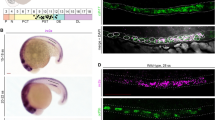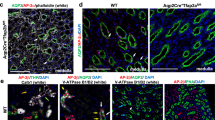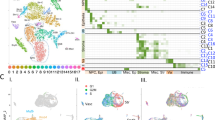Abstract
Glial cell line–derived neurotrophic factor signaling through the Ret receptor tyrosine kinase is crucial for ureteric bud branching morphogenesis during kidney development, yet few of the downstream genes are known. Here we show that the ETS transcription factors Etv4 and Etv5 are positively regulated by Ret signaling in the ureteric bud tips. Mice lacking both Etv4 alleles and one Etv5 allele show either renal agenesis or severe hypodysplasia, whereas kidney development fails completely in double homozygotes. We identified several genes whose expression in the ureteric bud depends on Etv4 and Etv5, including Cxcr4, Myb, Met and Mmp14. Thus, Etv4 and Etv5 are key components of a gene network downstream of Ret that promotes and controls renal branching morphogenesis.
This is a preview of subscription content, access via your institution
Access options
Subscribe to this journal
Receive 12 print issues and online access
$209.00 per year
only $17.42 per issue
Buy this article
- Purchase on Springer Link
- Instant access to full article PDF
Prices may be subject to local taxes which are calculated during checkout







Similar content being viewed by others
Accession codes
Change history
05 February 2010
In the version of this article initially published, the sentence under Table 1 on p. 1296 should stop after the words “and 430A arrays,” and the words “or >3 if represented on only one array” should be removed. In addition, on p. 1298, the second parenthesis after “Tg(Hoxb7-myrVenus)” is missing. These errors have been corrected in the HTML and PDF versions of the article.
References
Costantini, F. Renal branching morphogenesis: concepts, questions, and recent advances. Differentiation 74, 402–421 (2006).
Dressler, G.R. The cellular basis of kidney development. Annu. Rev. Cell Dev. Biol. 22, 509–529 (2006).
Schedl, A. Renal abnormalities and their developmental origin. Nat. Rev. Genet. 8, 791–802 (2007).
Saxen, L. Organogenesis of the Kidney (Cambridge University Press, Cambridge, UK, 1987).
Hoy, W.E. et al. Nephron number, glomerular volume, renal disease and hypertension. Curr. Opin. Nephrol. Hypertens. 17, 258–265 (2008).
Takahashi, M. The GDNF/RET signaling pathway and human diseases. Cytokine Growth Factor Rev. 12, 361–373 (2001).
Costantini, F. & Shakya, R. GDNF/Ret signaling and the development of the kidney. Bioessays 28, 117–127 (2006).
Skinner, M.A., Safford, S.D., Reeves, J.G., Jackson, M.E. & Freemerman, A.J. Renal aplasia in humans is associated with RET mutations. Am. J. Hum. Genet. 82, 344–351 (2008).
Sharrocks, A.D. The ETS-domain transcription factor family. Nat. Rev. Mol. Cell Biol. 2, 827–837 (2001).
Livet, J. et al. ETS gene Pea3 controls the central position and terminal arborization of specific motor neuron pools. Neuron 35, 877–892 (2002).
Chen, C. et al. ERM is required for transcriptional control of the spermatogonial stem cell niche. Nature 436, 1030–1034 (2005).
Brent, A.E. & Tabin, C.J. FGF acts directly on the somitic tendon progenitors through the Ets transcription factors Pea3 and Erm to regulate scleraxis expression. Development 131, 3885–3896 (2004).
Qiao, J., Sakurai, H. & Nigam, S.K. Branching morphogenesis independent of mesenchymal-epithelial contact in the developing kidney. Proc. Natl. Acad. Sci. USA 96, 7330–7335 (1999).
Pepicelli, C.V., Kispert, A., Rowitch, D.H. & McMahon, A.P. GDNF induces branching and increased cell proliferation in the ureter of the mouse. Dev. Biol. 192, 193–198 (1997).
de Graaff, E. et al. Differential activities of the RET tyrosine kinase receptor isoforms during mammalian embryogenesis. Genes Dev. 15, 2433–2444 (2001).
Basson, M.A. et al. Sprouty1 is a critical regulator of GDNF/RET-mediated kidney induction. Dev. Cell 8, 229–239 (2005).
Haase, G. et al. GDNF acts through PEA3 to regulate cell body positioning and muscle innervation of specific motor neuron pools. Neuron 35, 893–905 (2002).
Castellone, M.D. et al. Functional expression of the CXCR4 chemokine receptor is induced by RET/PTC oncogenes and is a common event in human papillary thyroid carcinomas. Oncogene 23, 5958–5967 (2004).
Watanabe, T. et al. Characterization of gene expression induced by RET with MEN2A or MEN2B mutation. Am. J. Pathol. 161, 249–256 (2002).
Colucci-D'Amato, G.L. et al. Abrogation of nerve growth factor-induced terminal differentiation by ret oncogene involves perturbation of nuclear translocation of ERK. J. Biol. Chem. 275, 19306–19314 (2000).
Michael, L. & Davies, J.A. Pattern and regulation of cell proliferation during murine ureteric bud development. J. Anat. 204, 241–255 (2004).
Schuchardt, A., D'Agati, V., Larsson-Blomberg, L., Costantini, F. & Pachnis, V. Defects in the kidney and enteric nervous system of mice lacking the tyrosine kinase receptor Ret. Nature 367, 380–383 (1994).
Majumdar, A., Vainio, S., Kispert, A., McMahon, J. & McMahon, A.P. Wnt11 and Ret/Gdnf pathways cooperate in regulating ureteric branching during metanephric kidney development. Development 130, 3175–3185 (2003).
Mucenski, M.L. et al. A functional c-myb gene is required for normal murine fetal hepatic hematopoiesis. Cell 65, 677–689 (1991).
Shi, M., Morris, S.M. Jr., Zoghbi, H., Porter, C.W. & O'Brien, W.E. Generation of a mouse model for arginase II deficiency by targeted disruption of the arginase II gene. Mol. Cell. Biol. 21, 811–813 (2001).
Buj-Bello, A., Biancalana, V., Moutou, C., Laporte, J. & Mandel, J.L. Identification of novel mutations in the MTM1 gene causing severe and mild forms of X-linked myotubular myopathy. Hum. Mutat. 14, 320–325 (1999).
Chotteau-Lelievre, A. et al. PEA3 transcription factors are expressed in tissues undergoing branching morphogenesis and promote formation of duct-like structures by mammary epithelial cells in vitro. Dev. Biol. 259, 241–257 (2003).
Firnberg, N. & Neubuser, A. FGF signaling regulates expression of Tbx2, Erm, Pea3, and Pax3 in the early nasal region. Dev. Biol. 247, 237–250 (2002).
Liu, Y., Jiang, H., Crawford, H.C. & Hogan, B.L. Role for ETS domain transcription factors Pea3/Erm in mouse lung development. Dev. Biol. 261, 10–24 (2003).
Chi, L. et al. Sprouty proteins regulate ureteric branching by coordinating reciprocal epithelial Wnt11, mesenchymal Gdnf and stromal Fgf7 signalling during kidney development. Development 131, 3345–3356 (2004).
Ohuchi, H. et al. FGF10 acts as a major ligand for FGF receptor 2 IIIb in mouse multi-organ development. Biochem. Biophys. Res. Commun. 277, 643–649 (2000).
Zhao, H. et al. Role of fibroblast growth factor receptors 1 and 2 in the ureteric bud. Dev. Biol. 276, 403–415 (2004).
Jain, S., Encinas, M., Johnson, E.M. Jr. & Milbrandt, J. Critical and distinct roles for key RET tyrosine docking sites in renal development. Genes Dev. 20, 321–333 (2006).
Jijiwa, M. et al. A targeting mutation of tyrosine 1062 in Ret causes a marked decrease of enteric neurons and renal hypoplasia. Mol. Cell. Biol. 24, 8026–8036 (2004).
Fisher, C.E., Michael, L., Barnett, M.W. & Davies, J.A. Erk MAP kinase regulates branching morphogenesis in the developing mouse kidney. Development 128, 4329–4338 (2001).
Tang, M.J., Cai, Y., Tsai, S.J., Wang, Y.K. & Dressler, G.R. Ureteric bud outgrowth in response to RET activation is mediated by phosphatidylinositol 3-kinase. Dev. Biol. 243, 128–136 (2002).
Chi, X., Hadjantonakis, A.K., Wu, Z., Hyink, D. & Costantini, F. A transgenic mouse that reveals cell shape and arrangement during ureteric bud branching. Genesis 47, 61–66 (2009).
Ishibe, S. et al. Met and the epidermal growth factor receptor act cooperatively to regulate final nephron number and maintain collecting duct morphology. Development 136, 337–345 (2009).
Kanwar, Y.S. et al. Role of membrane-type matrix metalloproteinase 1 (MT-1-MMP), MMP-2, and its inhibitor in nephrogenesis. Am. J. Physiol. 277, F934–F947 (1999).
Pohl, M., Sakurai, H., Bush, K.T. & Nigam, S.K. Matrix metalloproteinases and their inhibitors regulate in vitro ureteric bud branching morphogenesis. Am. J. Physiol. Renal Physiol. 279, F891–F900 (2000).
Koshikawa, N. et al. Proteolytic processing of laminin-5 by MT1-MMP in tissues and its effects on epithelial cell morphology. FASEB J. 18, 364–366 (2004).
Helmbacher, F. et al. Met signaling is required for recruitment of motor neurons to PEA3-positive motor pools. Neuron 39, 767–777 (2003).
Izumiyama, Y. et al. E1AF expression is closely correlated with malignant phenotype of tongue squamous cell carcinoma through activation of MT1-MMP gene promoters. Oncol. Rep. 13, 715–720 (2005).
Vu, T.H. & Werb, Z. Matrix metalloproteinases: effectors of development and normal physiology. Genes Dev. 14, 2123–2133 (2000).
Oblander, S.A. et al. Distinctive functions of membrane type 1 matrix-metalloprotease (MT1-MMP or MMP-14) in lung and submandibular gland development are independent of its role in pro-MMP-2 activation. Dev. Biol. 277, 255–269 (2005).
Meyer, T.N. et al. Spatiotemporal regulation of morphogenetic molecules during in vitro branching of the isolated ureteric bud: toward a model of branching through budding in the developing kidney. Dev. Biol. 275, 44–67 (2004).
Toth, M. et al. Complex pattern of membrane type 1 matrix metalloproteinase shedding. Regulation by autocatalytic cells surface inactivation of active enzyme. J. Biol. Chem. 277, 26340–26350 (2002).
Eswarakumar, V.P., Lax, I. & Schlessinger, J. Cellular signaling by fibroblast growth factor receptors. Cytokine Growth Factor Rev. 16, 139–149 (2005).
Qiao, J. et al. Multiple fibroblast growth factors support growth of the ureteric bud but have different effects on branching morphogenesis. Mech. Dev. 109, 123–135 (2001).
Schier, A.F. Chemokine signaling: rules of attraction. Curr. Biol. 13, R192–R194 (2003).
Maroni, P., Bendinelli, P., Matteucci, E. & Desiderio, M.A. HGF induces CXCR4 and CXCL12-mediated tumor invasion through Ets1 and NF-kappaB. Carcinogenesis 28, 267–279 (2007).
Shakya, R., Watanabe, T. & Costantini, F. The role of GDNF/Ret signaling in ureteric bud cell fate and branching morphogenesis. Dev. Cell 8, 65–74 (2005).
Chi, X. et al. Ret-dependent cell rearrangements in the Wolffian duct epithelium initiate ureteric bud morphogenesis. Dev. Cell 17, 199–209 (2009).
Takabatake, Y. et al. The CXCL12 (SDF-1)/CXCR4 axis is essential for the development of renal vasculature. J. Am. Soc. Nephrol. 20, 1714–1723 (2009).
Ramsay, R.G. & Gonda, T.J. MYB function in normal and cancer cells. Nat. Rev. Cancer 8, 523–534 (2008).
Michael, L., Sweeney, D.E. & Davies, J.A. The lectin Dolichos biflorus agglutinin is a sensitive indicator of branching morphogenetic activity in the developing mouse metanephric collecting duct system. J. Anat. 210, 89–97 (2007).
Wang, L.G., Liu, X.M., Li, Z.R., Denstman, S. & Bloch, A. Differential binding of nuclear c-ets-1 protein to an intron I fragment of the c-myb gene in growth versus differentiation. Cell Growth Differ. 5, 1243–1251 (1994).
Sullivan, J., Feeley, B., Guerra, J. & Boxer, L.M. Identification of the major positive regulators of c-myb expression in hematopoietic cells of different lineages. J. Biol. Chem. 272, 1943–1949 (1997).
Gambarotta, G. et al. Ets up-regulates MET transcription. Oncogene 13, 1911–1917 (1996).
Woolf, A.S. et al. Roles of hepatocyte growth factor/scatter factor and the met receptor in the early development of the metanephros. J. Cell Biol. 128, 171–184 (1995).
Santos, O.F. et al. Involvement of hepatocyte growth factor in kidney development. Dev. Biol. 163, 525–529 (1994).
de Launoit, Y. et al. The Ets transcription factors of the PEA3 group: transcriptional regulators in metastasis. Biochim. Biophys. Acta 1766, 79–87 (2006).
Li, C. & Hung Wong, W. Model-based analysis of oligonucleotide arrays: model validation, design issues and standard error application. Genome Biol. 2, RESEARCH0032 (2001).
Min, H. et al. Fgf-10 is required for both limb and lung development and exhibits striking functional similarity to Drosophila branchless. Genes Dev. 12, 3156–3161 (1998).
Arber, S. et al. Requirement for the homeobox gene Hb9 in the consolidation of motor neuron identity. Neuron 23, 659–674 (1999).
Schaeren-Wiemers, N. & Gerfin-Moser, A. A single protocol to detect transcripts of various types and expression levels in neural tissue and cultured cells: in situ hybridization using digoxigenin-labelled cRNA probes. Histochemistry 100, 431–440 (1993).
Weaver, M., Dunn, N.R. & Hogan, B.L. Bmp4 and Fgf10 play opposing roles during lung bud morphogenesis. Development 127, 2695–2704 (2000).
Acknowledgements
We thank S. Simonet (Amgen) for Fgf10−/− mice, K. Murphy (Washington University) for Etv5tm1Kmm mice, L. Williams and Z. Wu for technical assistance and N. Kurpios and C. Mendelsohn for critical comments on the manuscript. This work was supported by grant DK55388 (to F.C. and J.B.) and grant DK075578 (to F.C.) and by fellowships from the National Kidney Foundation (to C.C.), the American Heart Association (to X.C.) and the Sigrid Juselius Foundation and Finnish Cultural Foundation (to S.K.).
Author information
Authors and Affiliations
Contributions
B.C.L., C.C., X.C. and S.K. designed, conducted and interpreted experiments. R.K. conducted experiments. C.M.B., M.H., S.J., N.A. and M.T. contributed mutant kidneys. S.A., L.M. and J.H. generated the Etv5lacZ and Etv4lacZ mice. K.M.S.-O. and J.B. assisted with microarray analyses. V.D. analyzed renal histopathology. F.C. conceived and directed the project and wrote the manuscript. All authors edited the manuscript.
Corresponding author
Supplementary information
Supplementary Text and Figures
Supplementary Figures 1–6 and Supplementary Tables 1–5 (PDF 438 kb)
Rights and permissions
About this article
Cite this article
Lu, B., Cebrian, C., Chi, X. et al. Etv4 and Etv5 are required downstream of GDNF and Ret for kidney branching morphogenesis. Nat Genet 41, 1295–1302 (2009). https://doi.org/10.1038/ng.476
Received:
Accepted:
Published:
Issue Date:
DOI: https://doi.org/10.1038/ng.476
This article is cited by
-
E26 transformation-specific transcription variant 5 in development and cancer: modification, regulation and function
Journal of Biomedical Science (2023)
-
Targeting PEA3 transcription factors to mitigate small cell lung cancer progression
Oncogene (2023)
-
Human ureteric bud organoids recapitulate branching morphogenesis and differentiate into functional collecting duct cell types
Nature Biotechnology (2023)
-
Comparative whole-genome transcriptome analysis in renal cell populations reveals high tissue specificity of MAPK/ERK targets in embryonic kidney
BMC Biology (2022)
-
Integrating spatial transcriptomics with single-cell transcriptomics reveals a spatiotemporal gene landscape of the human developing kidney
Cell & Bioscience (2022)



